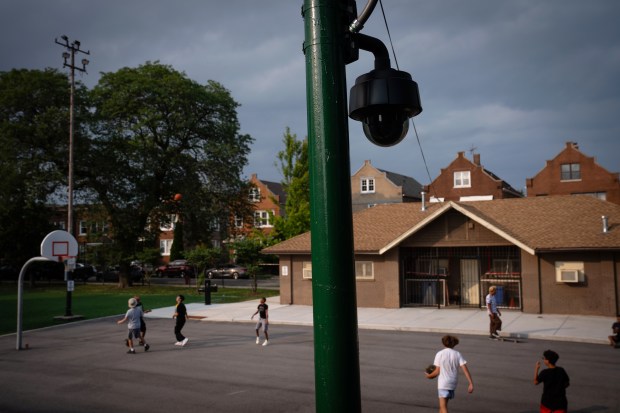This story is a collaboration between the Illinois Answers Project and the Chicago Tribune.
The police radio crackled with a report of six gunshots near a busy corner in Humboldt Park.
In a city that has struggled more than most to solve serious crimes, this summer 2023 shooting offered detectives an immediate advantage. At that corner, police had long ago mounted one of thousands of sophisticated surveillance cameras, the kind that could rotate around a 360-degree view, or zoom in to see activity up to four blocks away.
Sure enough, records show, an officer tapped into a live feed from the camera in time to see that a wounded victim had managed to get inside a restaurant. But the camera hadn’t captured images of the shooter. No video from the camera was put into evidence, and the case, like so many others, remains unsolved.
What happened that night in July 2023 underscores the potential and, at times, futility of the city’s massive, 20-year bet on a network of cameras typically affixed to utility poles across the city. In the shadow of the 2001 terrorist attacks and in a city with persistent crime problems, then-Mayor Richard M. Daley pushed the so-called Police Observation Devices as a game changer, one that would “stop violent crime before it occurs.”
Two decades, hundreds of millions of dollars and thousands of cameras later, an Illinois Answers Project and Chicago Tribune investigation has found that reality has fallen far short of those early promises. While installing thousands of police surveillance cameras has undoubtedly helped catch criminals and solve crimes, Chicago’s ever-growing system has yet to become the crime-fighting panacea Daley predicted.
In the absence of any comprehensive analysis from the city, the Tribune and Illinois Answers did their own assessment of Chicago’s POD camera program. After filing more than 100 open records requests and analyzing more than a dozen datasets, the investigation found:
- Police rarely credit these cameras with helping solve cases, even for the most serious crimes. For example, videos from Chicago police’s core inventory of roughly 4,400 surveillance cameras appeared to help solve, at best, 3.5% of 2023’s homicides.
- Officers don’t download video for most serious, unsolved crimes that occur on streets and sidewalks, the kind of crimes for which POD cameras were supposed to shine. Police data offers no record of video downloads in half of such open homicides, nearly three-fourths of open shootings and more than 90% of open robberies last year. The city didn’t download any footage from more than 1,000 POD cameras in 2023.
- A city-conducted study found cameras can be key crime-fighting tools if officers watch them in real time. But with so many cameras, and the Chicago Police Department’s ongoing struggle to fill officer vacancies, the vast majority of cameras go unwatched.
- Despite research suggesting cameras work best in carefully chosen places with higher crime, the city has put many in safer neighborhoods – at times at the behest of aldermen, in a review process with little paper trail and watered-down oversight. One study could document a significant drop in crime for only about 10% of the cameras it examined.
- City leaders have made it harder for the public to evaluate the effectiveness of the program by removing information about camera locations from CPD’s website. The department even sent officers to court last year to prevent the public release of that information.
In recent years, records show, police have ramped up efforts to make better use of their behemoth surveillance operation, which is anchored by city-owned PODs but also includes permitted access to roughly 35,000 other cameras owned by the CTA, schools and private businesses. The cameras also provide benefits to first responders that are difficult to quantify, as when the officer reviewing camera footage from the Humboldt Park shooting was able to tell responding police where the victim was.
Still, the Illinois Answers/Tribune analysis of city-owned PODs suggests the city has failed to follow best practices that could have prevented or solved more crimes and freed up money to hire more officers.
Meanwhile, city leaders continue to promise more cameras in response to crime upticks or large-scale public events, without offering evidence that more surveillance will bring more safety. Mayor Brandon Johnson’s administration added more than 70 new PODs during his first six months in office even though he expressed skepticism of police technology during his campaign.
Johnson declined to be interviewed for this report, as did representatives of the Chicago Police Department and the city’s Office of Public Safety Administration, which manages the POD program. Instead, the Johnson administration provided written statements to the newsrooms, stressing the significance of POD cameras in police work.
“Police Observation Devices (PODs) are an important crime-fighting tool used by the Chicago Police Department to view and respond to incidents as they occur in real time,” said Margaret Huynh, CPD’s assistant director of news affairs.
The investigation comes as local officials grapple with questions over the effectiveness of technologies pitched as making the city safer. The city’s transit system invested in tens of thousands of train and platform cameras that have done little to stem crime on the “L,” as underscored by the recent slayings of four people on the Blue Line earlier this month. Johnson recently defied the City Council by ending the city’s use of ShotSpotter microphones that detect gunshots, after describing the devices as little more than “a walkie-talkie on a pole.”
But even as city leaders are staring at a nearly $1 billion budget shortfall, they are asking few questions about the surveillance program that arguably started it all – the POD network, which has cost the city more than $100 million in the past seven years, or nearly double the tally for Shotspotter in that same period.
In the past two decades, the city has spent at least $279 million on PODs, according to the Tribune/Illinois Answers investigation, but the total is likely much more since that figure covers only the city’s payments to outside vendors. Nobody at the city can say, for sure, how much money has been spent on the program overall. Meanwhile, aldermen regularly clamor for more cameras to be installed as part of a tough-on-crime pitch to constituents — regardless of where cameras may be put to best use.
The result is that Chicago is home to a surveillance network that is one of the largest and most sophisticated in the country yet is operated with little transparency or accountability, in a city where rates of violent crime remain higher than those in New York and Los Angeles.
“In a real functioning city and society that had a functioning City Council, all of these tools would be questioned every year,” said Tracy Siska, executive director of the Chicago Justice Project, a criminal justice advocacy organization. “People need to answer for what these cameras are actually doing.”
In that void of information, residents express wildly different views on the PODs’ usefulness. Some pester aldermen to install more. Others see the cameras as a waste of money.
Nita Hailey-Gamble, whose Humboldt Park office is within view of the camera officers used after the July 2023 shooting, said she thinks PODs do little to fight crime. She wishes the city would spend the money instead on strategies to help people avoid the cycle of crime and violence.
“People don’t care about them,” she said of the cameras. “If they’re going to shoot, they’re going to shoot.”
A new program’s promise
Twenty years before the Humboldt Park shooting, Daley gathered top police officials at a news conference to unveil “Operation Disruption.”
On certain drug- and gang-plagued corners, the city would install cameras that could rotate 360 degrees and zoom in from far distances. They’d be put atop utility poles in white steel boxes with flashing blue lights — a clear warning to would-be wrongdoers. A pilot program would start with five cameras along Chicago Avenue in the Harrison Police District (11th), including one on the corner where the July 2023 shooting later took place.
“When criminals are being watched, they alter their behavior drastically,” Terry Hillard, then CPD superintendent, said while announcing the operation in 2003.
Daley and police officials soon declared the pilot program a success. By 2005, the network had grown to 100 cameras, with officials bragging that newer models could capture scenes two to three blocks away and relay feeds directly to the 911 center.
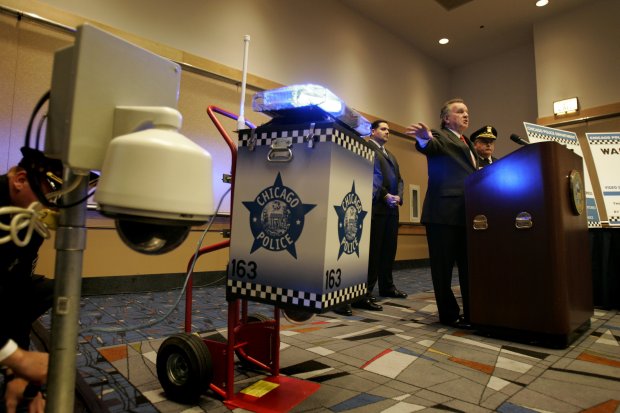
Year by year, the number of cameras grew. Their capabilities sharpened. City officials touted their success.
Researchers began studying the program, at times with federal funding obtained by the city. And their work affirmed the cameras’ benefits — at least at first glance.
An Urban Institute study on the cameras’ first three years found drug, robbery and weapons crimes decreased after cameras were installed in Humboldt Park, one of two neighborhoods included in the report. A 2022 study conducted by an Illinois Institute of Technology researcher assessed what by then was a far more expansive system and found crime collectively decreased in areas around PODs compared with areas without.
However, the findings came with caveats: Not all cameras were equal.
The first study, on the PODs’ early years, found little change in crime levels after cameras were installed in the second neighborhood, West Garfield Park.
More startling was a revelation mentioned deep in the 2022 report. When the researchers looked at PODs individually, they could document notable crime drops for only a tenth of the cameras that were studied.
“A large number of cameras did not have a statistically significant decrease in crime,” the researchers wrote.
When asked about this finding, Dan Casey, managing deputy director of information technology with the Office of Public Safety Administration, called it “a lot of speculation” but declined to respond to follow-up questions.
The lead authors of the two studies declined to comment to Illinois Answers and the Tribune, but both reports concluded that crime levels are a key factor in identifying locations where cameras would be most effective.
City leaders acknowledged as much when they launched the POD program, promising to assess each camera’s impact and adjust their locations accordingly.
Chicago police officials said they would formally evaluate the effectiveness of the pilot program in 2003. They later said they would set up a special committee on POD surveillance that would analyze crime trends and figure out where best to put new cameras or move them around. Department rules also required police to create “exit strategies” for removing each camera after its crime-reduction work had been “accomplished.”
The Better Government Association, which publishes the Illinois Answers Project, filed an open records request with the city to see the required periodic reviews in September 2023, then filed a lawsuit when the city failed to produce them. A city Office of Public Safety Administration official finally acknowledged in May that no such records existed.
“PSA has not performed periodic reviews, and to the best of my knowledge, periodic reviews have not been performed by any other City department,” Office of Public Safety Administration Deputy Director Leon Leak wrote in an affidavit.
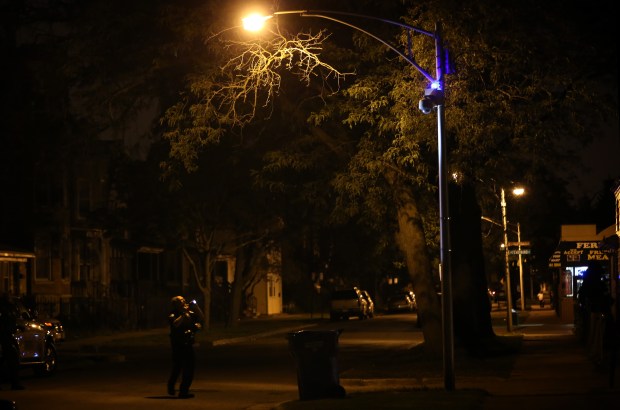
By 2019, the number of POD cameras topped 3,000. Instead of recommitting to comprehensive studies, CPD that year chose to dilute its rules. No longer did the department need to document the impact of each camera on the community or develop plans to keep crime down after a POD camera is removed.
That same year, the nonprofit research organization RAND recommended in a study that the department develop “analytic models” to determine precisely where to place cameras, based on available data. Police and public safety officials did not respond to requests for records on any such models and declined to answer questions.
A fragmented network
In all, the city owns more than 6,000 surveillance cameras, Casey said. More than a thousand are mounted on or in city buildings, with hundreds more either affixed to movable objects ranging from helicopters to trailers, or newly deployed and yet to be categorized. But the vast majority — roughly 4,400 — are POD cameras. The city would not release precise locations on any of the devices but did disclose how many POD cameras are located in each district and police beat.
An analysis of that data shows the cameras are far from evenly distributed. Of the city’s nearly 300 police beats, some contained more than 100 PODs, but most beats had fewer than a dozen. A handful had none.
One explanation for these disparities could be that areas with more crime got more cameras, but the Tribune and Illinois Answers found the opposite was often true.
For example, the Near North District (18th) — spread across the Near North Side and much of Lincoln Park — had 431 cameras at the end of 2023. By contrast, the West Side’s Harrison District (11th) — the birthplace of the POD program — had a third fewer cameras despite experiencing more than twice as many violent crimes in the past five years.
Or compare the Near North District to the South Side’s Gresham District (6th), which had double the crime of Near North but a third of the cameras.
Asked why so many cameras were concentrated in the Loop and along the north lakefront, the city said many of those cameras were funded with federal anti-terrorism grants to better deter, detect and respond to threats in the heart of the city.
But the Illinois Answers/Tribune analysis still found significant disparities even after excluding police beats with potential terrorism targets, such as those in the Loop and along the Magnificent Mile, those containing the United Center, Wrigley Field and Guaranteed Rate Field and lakefront beats from Edgewater Beach all the way south to Rainbow Beach.
For example, consider the relatively safe Beat 1921 in the North Center neighborhood, between Irving Park Road and Belmont Avenue, west of Damen Avenue to the North Branch of the Chicago River. It had 34 active POD cameras at the end of last year. More than 100 beats across the city had at least twice as much violent crime in the past five years as Beat 1921 yet less than half the number of POD cameras.
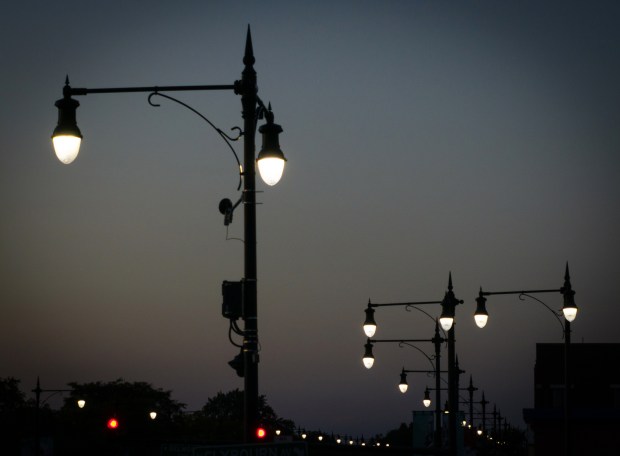
The city’s refusal to release the specific location of each camera makes it difficult to do a more precise analysis. But the available information indicates anti-terrorism strategies and crime levels can’t fully explain the wide variation in which places get cameras and which don’t.
In a statement, Casey with the Office of Public Safety Administration said a team from his department worked with Chicago police to review requests for new city-owned PODs and prioritize installations based on crime rates and where cameras are already located. But in response to several open records requests for documentation of any such assessments, the city provided nothing.
While the city said most POD requests originate with police, aldermen can also request them — with the idea being that local leaders are most familiar with the needs of their community. Those requests can contribute to the patchwork nature of the system.
“They haven’t really had a comprehensive strategy,” said Ald. Scott Waguespack, 32nd. He said police leaders in his North Side ward analyze crime data to determine where to put up new cameras, but there’s no guarantee other wards do the same.
“I think there’s a lot of pressure on people for cameras on this ad hoc basis,” Waguespack said.
West Side Ald. Jason Ervin, 28th, said resident requests are a key factor in how he determines where to request cameras.
“It’s not necessarily in the data. It’s in how people’s perception of what they feel the safety is,” Ervin said.
In the Hyde Park neighborhood, residents long resisted POD cameras, which explains why one police beat in that ward for years had no POD installed.
“The will of the community is really strong in Hyde Park,” said Charles Kyle, chief of staff for Ald. Desmon Yancy, 5th. “They don’t want to feel like they are in a police state.”
That’s now changing, Kyle said. Even if the cameras have little real-world impact on local crime, he said, the alderman plans to honor their wishes and request a new camera.
“If you give people the perception of safety, it makes them feel a little better,” Kyle said.
Uneven camera use
A possible result of this haphazard deployment is that some cameras get a lot of use, while others appear to get little, if any.
One way to look at it is how often officers download videos from each camera.
Of the POD cameras active for all of last year, the busiest was in the Harrison District, a Tribune/Illinois Answers analysis of police data found. Police downloaded 85 videos, or roughly one every four days, typically for help with homicides, shootings and robberies but also to document drug deals and track down a hit-and-run driver.
But the vast majority of cameras — nearly 3,100 — had fewer than 10 videos downloaded last year. And more than 1,000 cameras logged no downloads at all.
When asked about the thousands of cameras where little to no video was downloaded, city officials emphasized that cameras are used in many ways.
“Downloads are only one measure of a camera’s utility,” said Casey with the Office of Public Safety Administration. “Many cameras in the central business district are constantly being viewed live.”
When the POD program started more than 20 years ago, officers parked nearby and controlled joysticks to maneuver cameras to catch criminals unaware. After cameras got better and could transmit live feeds across the city, officers or civilian staffers would more typically sit in a police station, watching a screen displaying multiple camera views and keeping an eye out for anyone who might be dealing drugs or holding guns. Sometimes the cameras are part of dedicated stings targeting particular hot spots.
Over the past decade, police have expanded officers’ ability to view cameras in real time in each district. In one of the few available examples of CPD researching effective strategies for using police cameras, the department in 2019 reported that a federally funded study had found active monitoring of cameras to be “significantly effective,” namely by bringing about more arrests.
But there’s one big problem with active monitoring: In a city where police can access live views from more than 40,000 cameras in the larger federated network, it’s impossible to watch every camera, every minute — particularly in a short-staffed department that struggles to quickly respond to many serious 911 calls.
The department has said it hasn’t found software that can automatically analyze their live feeds and issue alerts to officers, similar to how the ShotSpotter program notified officers of suspected gunshots. The Chicago Transit Authority has begun testing a system that uses artificial intelligence to spot any guns that might appear in video feeds from “L” station cameras. Chicago police did not respond to a question about whether that agency is considering such software for PODs.
Police, for now, must still rely on humans to watch cameras. And that means trying to figure out which cameras to watch and when. To try to help police build and optimize algorithms that could inform such choices, IIT researchers developed a list of characteristics that would identify which cameras were more likely to capture criminal activity at any given time. Police and public safety officials did not respond to questions about whether they have put IIT’s research to use.
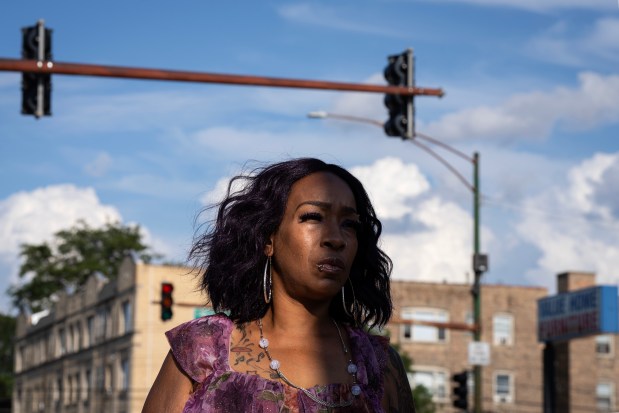
Unanswered questions on how police use POD cameras have real consequences for people like Brandy Martin, who have lost loved ones to unsolved violent crimes.
Martin’s 15-year-old nephew, Sincere Cole, was shot more than 20 times on the sidewalk outside a gas station in February 2022 — just 300 feet from a POD camera in the Chicago Lawn neighborhood.
In the aftermath, Martin held a news conference to plead with the public and police to do all they could to find the teen’s killer. She hoped that surveillance video — of any kind, from the gas station or from PODs — would help solve the case.
“I am pleading for help from my city,” Martin said. “All footage, every camera, I need that.”
In available police records and data, there’s no indication that detectives investigating the shooting downloaded any video from the POD. The heavily redacted police reports don’t make the reason clear, frustrating Martin.
More than two years later, the Sincere Cole case remains unsolved. Representatives for the police and the Office of Public Safety Administration declined to answer questions about the investigation.
Aiding arrests

Some investigations highlight the promise of PODs. Video from the police shooting of Dexter Reed in March demonstrates how newer cameras can zoom in to a crime scene from more than a block away. Prosecutors credited POD footage with helping track the man they say killed Officer Luis Huesca in an early morning shooting in April in Gage Park.
And the infamous Jussie Smollett case provided a rare glimpse into the extensive material police detectives can cull from PODs and private security cameras. The crime took place in a police beat saturated with more than 60 POD cameras, and police credited 35 PODs and more than 20 private-sector cameras with helping trace the suspects’ movements.
However, these cases also show the limitations of the vast surveillance network.
In the Huesca shooting, when detectives asked for the public’s help in putting a name to a face, the surveillance video they released was not obtained from a POD. In the Reed case, a POD at the intersection where the shooting occurred malfunctioned and failed to record any footage, according to the Civilian Office of Police Accountability. Not until several minutes after Reed fired on an officer and officers fired back did police use a POD down the street to zoom in close to the scene.
And although prosecutors say Smollett intentionally staged his fake hate crime near a POD, hoping it would capture the incident, the camera was pointed in the opposite direction and failed to capture the hoax.
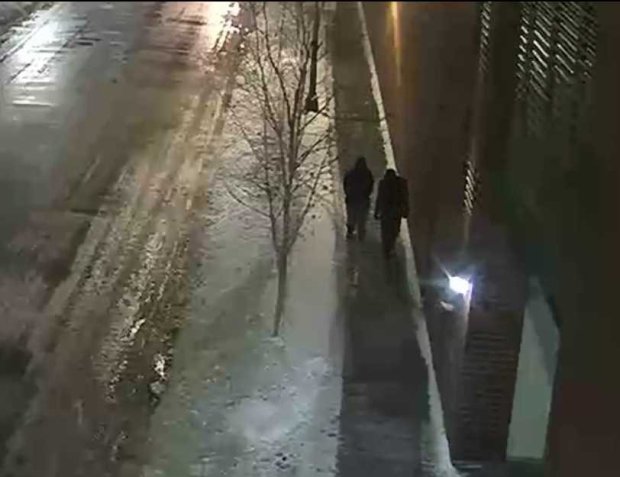
The anecdotes help frame a far more nuanced reality of the cameras’ effectiveness than city officials typically present — a reality also reflected in a Illinois Answers/Tribune analysis of police arrest, clearance and POD data.
Almost since the beginning of the POD program, police officers have been told to record which arrests were significantly aided by POD cameras. An analysis of that data, obtained through an open records request, found officers credited PODs in only 3% of all arrests last year.
Arrests for drug or gun possession accounted for roughly half of those cases, the analysis found. It’s unclear how many of those nearly 700 arrests resulted from stings in which officers actively monitored cameras, versus after-the-fact investigations of crimes. But police dispatch logs show police routinely conduct such stings across the city.
Chicago police have long struggled to meet recordkeeping obligations, raising questions about whether the cameras are more helpful to police than their data suggests. To address this issue, reporters broadened their analysis to include not only cases when officers indicated that a POD had aided an arrest, but also cases when POD video was inventoried in case files or downloaded in the same beat and around the same time as a crime was reported.
The resulting analysis identified 22 cleared homicide cases last year that appeared to make use of POD videos. Chicago saw more than 600 homicides in 2023.
For shootings, the analysis identified 47 cleared cases where police used POD video, out of more than 1,900 incidents.
These low rates occurred even though the department has dramatically increased the space, manpower and technology devoted to video analysis, resulting in an eightfold increase in videos downloaded over the past decade. By last year, the agency was downloading an average of two POD videos every hour.
But use of the cameras still varies widely. Some cases result in a dozen or more video downloads. Others get none, even for serious, violent crimes occurring on streets or sidewalks — the kinds of cases for which POD cameras seem best suited.
For open cases involving homicides that occurred on streets or sidewalks last year, reporters could find records of POD video downloads in just 43% of the incidents. For unsolved shootings in similar settings, the percentage dropped to 26%. For robberies, it was 6%.
In other words, there has been a massive jump in downloads from PODs, yet video use still leads to few arrests in serious crimes, and there is no record of POD use for many serious cases. While broadly touting the effectiveness of PODs, current police officials did not respond to questions on these findings.
Anthony Riccio, a former first deputy superintendent for the department, said in an interview that police practices evolved over the past decade to aggressively hunt for videos, often in the early moments after a serious crime occurred. In other words, he said, when police don’t credit cameras in the most serious cases, it’s typically not for a lack of effort.
In some cases, there may not be a POD camera able to capture images of a crime or the getaway.
Even in a city widely considered to be one of the most surveilled in the United States, more Chicago corners lack POD coverage than have it. Even if a corner has a camera, it may not be working. City records show that, at any given time last year, an average of one in 14 cameras was out of service.
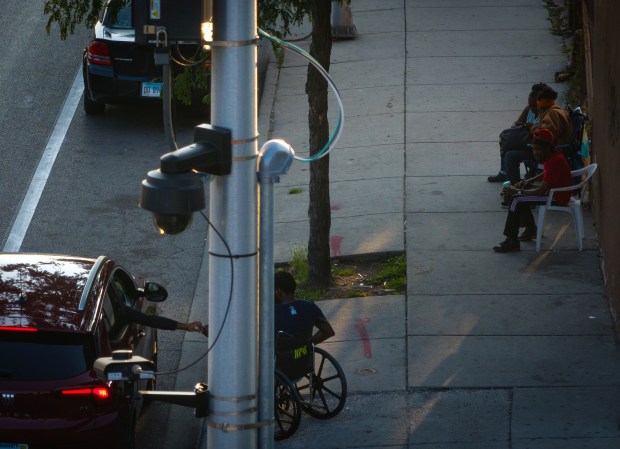
And even if there is a camera close to a crime — and it’s working — officers may discover it still didn’t capture enough information to make the video worth downloading or putting into evidence.
Making matters harder, at times, is the PODs’ position atop tall poles. The cameras may capture a broad view of the scene, perhaps helping confirm or refute a general sequence of events, or getting basic details about a getaway car. But the angle can make it harder to positively identify a suspect or see a license plate number.
So detectives may turn to residents’ doorbell cameras or other digital evidence that may offer a better angle.
“You can catch somebody with a nice Ring doorbell,” said Riccio, who retired in 2020 after 34 years on the force. “The quality is fantastic on the cheaper cameras. A lot of times detectives go out and canvass for that.”
Ald. Jeanette Taylor, of the South Side’s 20th Ward, said she isn’t surprised PODs help solve so few crimes.
“We’re programmed to think that those things make us safe and that they’ll make a difference, (but) those things alone … they don’t work,” she said. She argued that the city should eliminate the POD program and instead focus on more proven crime- and violence-reduction strategies.
“It should be scrapped altogether and there should be conversations within the community on what is the need,” Taylor said.
‘In the dark’
Early in the POD program, much of the skepticism about the cameras came from privacy advocates. Two decades later, some advocates continue to question whether the privacy loss is worth any safety gained.
“We oftentimes get these far-reaching promises of what it is that these glorious systems will do,” said Ed Yohnka, director of communications and public policy for the ACLU of Illinois. “They are implemented … and then afterward there’s no real analysis as to whether or not it fulfilled any function that was part of the promise in the first instance.”
Any such public analyses would be missing a crucial piece of information: exactly where the current cameras are located.
City leaders publicized the location of cameras when the program began in the 2000s on the argument that it would deter criminals.
But in recent years the city reversed that policy, though without announcing the change publicly. The Police Department even went to court to prevent the public from accessing data on the locations — arguing now that criminals were best deterred by not knowing the locations.
“Analysis of active shooter incidents and other crimes demonstrate that criminals do their homework,” Casey wrote in response to questions from the Tribune and Illinois Answers. “Having this data publicly available would provide useful information for anyone planning a crime or attack.”
The City Council, for its part, has done little to dig into a program they’ve directed hundreds of millions of dollars into for two decades. The legislative body has never held hearings to question the POD program’s effectiveness, privacy rules or cost.
Ask city officials how much has been spent on the cameras over the years, and you’ll get the bureaucratic equivalent of a shrug from City Hall, Chicago police and the Office of Public Safety Administration.
Using information obtained through public records requests and lawsuits against the city, Illinois Answers and the Tribune estimate the city has spent at least $279 million since the program began in 2003. However, that number covers only the money the city has paid to vendors to maintain the program and doesn’t include salaries for people monitoring cameras and other internal administrative costs, which the Urban Institute’s 2011 study estimated made up 50% of the camera program’s overall cost to the city.
The vast majority of the identified payments went to Motorola, which has held the city’s camera maintenance contract since 2010.
For the past five years, the company has taken in an average of $18 million a year through the camera contract. The contract was originally set to expire in 2015, but the city has extended the agreement eight times. The Office of Public Safety Administration said in June that it intended to open the contract to new vendors through a competitive request for proposals “very soon.” The office then extended the deal another year, through the end of 2025, and later said it still hoped to “soon” begin a competitive process for a new deal.
Matthew Guariglia, a senior policy analyst with the Electronic Frontier Foundation, said the lack of access to basic information about the POD program is concerning on multiple fronts.
“Departments will pay hundreds of thousands and millions of dollars to mount some massive surveillance system, and the public will really be in the dark about how it’s used, when it’s used, where the things are located,” he said.
The opacity and mixed results of the camera program over two decades is typified by the camera on the corner where the July 2023 shooting took place: Chicago and Central Park avenues in Humboldt Park.
The corner is generally run-of-the-mill, surrounded by apartments, a housing nonprofit and small businesses including a Whale Fish & Chicken fast-food restaurant. But the corner is also historic in one sense: No other location in the city has had a POD camera for longer.
Central Park was one of the first five spots along Chicago Avenue to get a camera, back when they were in the big boxes with flashing blue lights. The other four lost their big-box cameras at a time when the city was more willing to move them to other hot spots. Now the cameras typically stay in the place they were installed.
Last year, officers downloaded 27 videos from a newer camera on that corner, ranking it in the top 2%. Most of the downloads appear to be related to homicides, shootings and robberies that happened elsewhere, with the camera being used to track suspects traveling through the neighborhood
Whether those videos helped solve any of those crimes is difficult to determine. But it’s clear the camera didn’t help much with serious crimes that occurred nearby.
Chicago police recorded 18 serious, violent crimes occurring on the street or sidewalk within a block of the camera last year. Police data show that three were cleared, with no credit given to the camera for helping out.
As for the 15 cases that are still open, police data suggests that officers consulted the camera in, at most, five cases: the July shooting, a sexual assault and three robberies.
Police declined to release detailed investigative reports for these cases or to answer questions that might shed light on how helpful the camera was and what has stalled each case.
But in the case of the July shooting, victim Michael Levy told the Tribune in a brief interview that he suspects the reason the POD wasn’t useful was simple physics.
He said he was shot beside the restaurant, between the street and an alley. The shooter fled down the alley.
And, he suspects, the camera couldn’t see any of it.
Former Illinois Answers Project reporter Matt Stroud contributed to this story.


